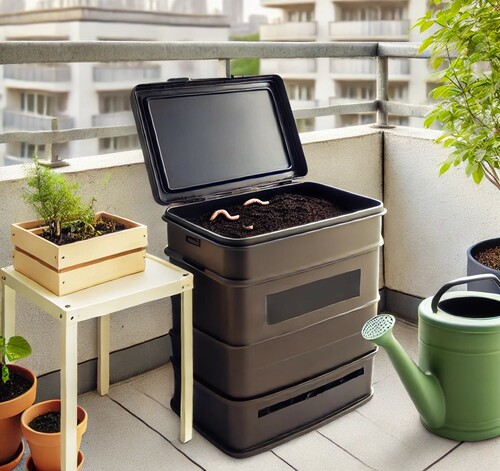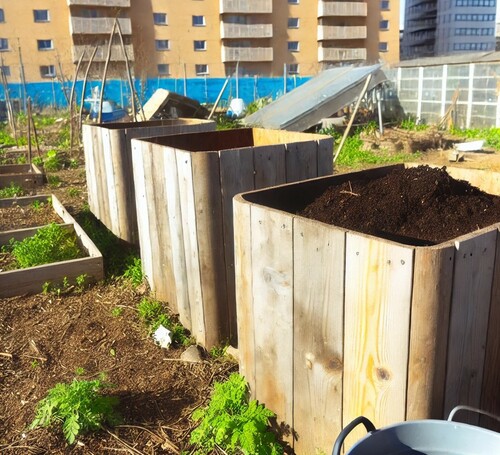Composting in Urban Environments: Solutions for City Dwellers
Introduction
In the hearts of bustling cities, urban dwellers are increasingly turning to composting as a way to reduce waste and contribute to a more sustainable lifestyle. Composting in urban environments involves breaking down organic waste materials into nutrient-rich soil, even within the constraints of city living. This process not only reduces the amount of waste sent to landfills but also creates a valuable resource for urban gardening and green spaces.
The challenges of urban composting often stem from limited space, concerns about odors and pests, and local regulations that may restrict certain composting practices. However, these challenges have sparked creative solutions , leading to the development of space-efficient composting methods, odor control techniques, and community-based initiatives.
This article explores various approaches to urban composting, from space-saving techniques like vermicomposting and Bokashi to indoor composting solutions and community-based programs. We’ll also delve into practical tips for managing common issues and navigating legal considerations, empowering city dwellers to embrace composting as part of their urban lifestyle.
Space-Saving Composting Techniques

An Efficient Vermicomposting Setup on a City Apartment Balcony
When it comes to composting in tight spaces, two methods stand out for their efficiency and compactness: vermicomposting and Bokashi composting.
Vermicomposting
Vermicomposting, or worm composting, is an excellent option for urban dwellers with limited space. This method uses specific types of worms, typically red wigglers , to break down organic waste into nutrient-rich castings.
Key aspects of vermicomposting include:
- Compact Setup: A small bin or tray system can fit under a sink or in a closet.
- Efficient Decomposition: Worms can process about half their body weight in food scraps daily.
- Odor Free when Properly Maintained: The aerobic process produces minimal odor.
- Versatility: Can handle most kitchen scraps, excluding meat, dairy, and oily foods.
To start vermicomposting:
- Choose a suitable container with drainage holes and a lid.
- Create bedding using shredded newspaper, cardboard, or coconut coir.
- Add red wiggler worms (about one pound per square foot of surface area).
- Begin adding small amounts of food scraps, burying them in the bedding.
- Harvest the castings every 3-6 months, depending on the bin size and worm population.
Bokashi
Bokashi is a fermentation-based composting method originating in Japan. It’s an anaerobic process that uses beneficial microorganisms to break down organic matter, including meat and dairy products that are typically avoided in traditional composting.
Key features of Bokashi composting:
- Space-efficient: Uses a sealed bucket system that can fit in a kitchen cabinet.
- Rapid process: Fermentation typically takes only 2-4 weeks.
- Handles a wide range of organic waste: Can process meat, dairy, and oily foods.
- Produces nutrient-rich compost tea: Liquid fertilizer is a byproduct.
Steps to start Bokashi composting:
- Obtain a Bokashi bucket with a tight-fitting lid and a spigot for draining liquid.
- Layer food scraps with Bokashi bran (inoculated with effective microorganisms).
- Press down each layer to remove air pockets.
- Seal the bucket between additions and drain liquid every few days.
- After 2-4 weeks, bury the fermented matter in soil or add to a traditional compost pile to complete the process.
Both vermiposting and Bokashi offer urban dwellers efficient ways to compost without requiring large outdoor spaces, making them ideal solutions for apartment living or homes with small yards.
Indoor Composting

A Stylish Indoor Compost Bin in a Cozy Urban Apartment
For those without access to outdoor space, indoor composting provides a viable alternative to traditional outdoor methods. With the right equipment and management techniques, indoor composting can be a clean, odor-free process that fits seamlessly into urban living.
Equipment Needed
The success of indoor composting largely depends on choosing the right equipment. Here are some essential items:
1. Indoor Compost Bins: These specially designed containers are crucial for containing the composting process and managing potential odors and pests. Look for bins with the following features:
- Tight-fitting lid to control odors and prevent pest intrusion
- Good ventilation to promote aerobic decomposition
- Drainage system to manage excess moisture
- Easy access for adding materials and harvesting compost
2. Carbon-rich Materials: Also known as “browns,” these include:
- Shredded newspaper or cardboard
- Dry leaves
- Sawdust (from untreated wood)
3. Nitrogen-rich Materials: Often referred to as “greens,” these include:
- Fruit and vegetable scraps
- Coffee grounds and tea bags
- Eggshells
4. Compost Thermometer : To monitor the temperature of your compost pile
5. Small Garden Fork or Trowel: For turning and aerating the compost
6. Moisture Meter : To ensure optimal moisture levels in your compost.
Managing Odors and Pests
Proper management is key to preventing odors and deterring pests in indoor composting:
- Maintain the Right Balance: Aim for a ratio of about 3 parts carbon-rich materials to 1 part nitrogen-rich materials. This balance helps control odors and speeds up decomposition.
- Avoid Problematic Materials: Do not compost meat, dairy, or oily foods indoors, as these can create strong odors and attract pests.
- Chop Materials Finely: Smaller pieces decompose faster and are less likely to attract pests.
- Control Moisture: The compost should be moist but not soggy. If it’s too wet, add more dry, carbon-rich materials.
- Aerate Regularly: Turn your compost weekly to provide oxygen, which promotes aerobic decomposition and reduces odors.
- Use Natural Odor Absorbers: Sprinkle a thin layer of finished compost, sawdust, or crushed eggshells over fresh food scraps to absorb odors.
- Clean Bins Regularly: Wash your compost bin with mild soap and water every few months to prevent buildup of odor-causing bacteria.
- Store Smartly: Keep your compost bin in a well-ventilated area, away from direct sunlight and heat sources
By following these guidelines, urban dwellers can successfully compost indoors without compromising their living space or comfort. Indoor composting not only reduces waste but also provides a continuous supply of nutrient-rich soil for houseplants and small container gardens, contributing to a greener urban lifestyle.
Community Composting

Eco-Friendly Community Compost Bins in an Urban Setting
When individual composting efforts are challenging due to space constraints or local regulations, community composting offers an excellent alternative for urban dwellers to participate in this eco-friendly practice.
Benefits
Community composting brings numerous advantages to urban environments:
- Social Cohesion: Brings neighbors together, fostering a sense of community and shared purpose.
- Education: Provides hands-on learning opportunities about waste reduction and sustainable practices.
- Larger-scale Impact: Collectively diverts more organic waste from landfills than individual practices.
- Resource Sharing: Allows for sharing of equipment, knowledge, and the resulting compost.
- Green Space Enhancement: Produces compost for community gardens and public green spaces.
- Local Food Production: Supports urban agriculture initiatives by providing nutrient-rich soil.
- Cost-effectiveness: Reduces waste management costs for municipalities.
How to Start or Join
Getting involved in community composting can be straightforward:
1. Research Existing Programs:
- Check with local environmental organizations
- Inquire at community gardens
- Contact your city’s waste management department
2. Join an Existing Program:
- Sign up for a compost drop-off service
- Volunteer at a community composting site
- Participate in a compost co-op
3. Start a New Program:
- Gauge interest among neighbors and local businesses
- Identify a suitable location (e.g. community garden, school, or vacant lot)
- Obtain necessary permits from local authorities
- Secure funding through grants or community contributions
- Set up composting system (e.g. bins, tumblers, etc.)
- Establish guidelines for acceptable materials and drop-off procedures
- Organize volunteers for maintenance and education
4. Educate and Engage:
- Host workshops on composting basics
- Create informational materials for participants
- Organize compost giveaway events for the community
5. Partner with Local Businesses:
- Collaborate with cafes, restaurants, and grocery stores to collect food scraps
- Work with landscaping companies for yard waste collection
6. Monitor and Improve:
- Regularly assess the program’s effectiveness
- Seek feedback from participants
- Adjust processes as needed to ensure success and sustainability
By participating in or initiating community composting efforts, urban residents can overcome individual limitations and create a significant positive impact on their local environment.
Urban Composting Tips

Wooden Compost Bins for Sustainable Urban Gardening
Successful urban composting requires attention to detail and adherence to best practices. Here are some essential tips to ensure your composting efforts thrive in an urban setting:
- Balance Your Materials: Maintain a proper ratio of “browns” (carbon-rich materials) to “greens” (nitrogen-rich materials). Aim for about 3 parts brown to 1 part green.
- Chop Materials: Cut or shred larger items into smaller pieces to speed up decomposition.
- Monitor Moisture: Keep your compost moist but not waterlogged. It should feel like a wrung-out sponge.
- Aerate Regularly: Turn your compost weekly to provide oxygen and prevent anaerobic conditions.
- Control Temperature: Use a compost thermometer to monitor heat. The center should reach 130-150°F (54-66°C) for optimal decomposition.
- Avoid Problematic Materials: Keep meat, dairy, oils, and diseased plants out of your compost to prevent odors and pests.
- Use Compost Activators: Add finished compost, garden soil, or commercial activators to introduce beneficial microorganisms.
- Manage Seasonal Changes: Adjust your composting practices based on weather conditions. In colder months, insulate your bin or move it to a warmer location.
- Harvest Regularly: Remove finished compost from the bottom of your bin to make room for fresh materials.
- Apply Finished Compost: Use your nutrient-rich compost in container gardens or houseplants, or donate to community green spaces.
Legal and Space Considerations
Navigating legal requirements and maximizing limited space are crucial aspects of urban composting:
1. Check Local Regulations:
- Research city ordinances regarding composting
- Obtain necessary permits if required
- Ensure compliance with any restrictions on bin placement or materials
2. Communicate with Neighbors:
- Inform nearby residents about your composting efforts
- Address any concerns proactively
- Consider sharing your compost or knowledge with interested neighbors
3. Maximize Vertical Space:
- Use tiered composting systems
- Explore wall-mounted or hanging composting options
4. Utilize Overlooked Areas:
- Compost in unused corners of balconies or patios
- Consider under-sink composting systems for kitchens
5. Opt for Compact Solutions:
- Choose smaller, well-designed composting bins
- Explore options like Bokashi or vermicomposting for tight spaces
6. Collaborate with Local Businesses:
- Partner with nearby cafes or restaurants to compost their organic waste
- Ensure any such arrangements comply with local health and safety regulations
7. Join or Create a Community Composting Program:
- Participate in shared composting efforts if individual composting is restricted
- Work with local authorities to establish community composting sites
By considering these legal and space-related factors, urban dwellers can find creative ways to incorporate composting into their lifestyles while respecting local regulations and special constraints.
Conclusion

Rich, Finished Compost Held in an Urban Community Garden
Composting in urban environments is not just possible; it’s a crucial step toward creating more sustainable cities. From space-saving techniques like vermicomposting and Bokashi to community-based initiatives, urban dwellers have a variety of options to reduce waste and contribute to a healthier environment. By embracing these methods and following best practices, city residents can overcome the challenges of limited space and turn their organic waste into a valuable resource for urban gardening and green spaces.
As we’ve explored, successful urban composting requires a combination of the right techniques, equipment, and knowledge. Whether you choose to compost indoors, participate in a community program, or find innovative ways to compost in small outdoor spaces, your efforts contribute to reducing landfill waste, lowering greenhouse gas emissions, and creating nutrient-rich soil for urban plants.
Remember that every small action counts. By composting, you’re not just managing waste; you’re participating in a broader movement toward more sustainable and resilient cities. As you embark on or continue your composting journey, don’t hesitate to experiment with different methods to find what works best for your unique urban living situation.
For more information on urban composting techniques or professional tree care services that can benefit from your composting efforts, contact Arborist Now . Our team of expert arborists can help you maximize the benefits of your compost in maintaining healthy urban green spaces.
We may receive affiliate compensation for some of the links below at no cost to you if you decide to make a purchase.


